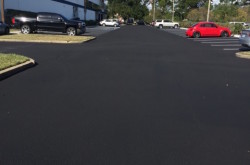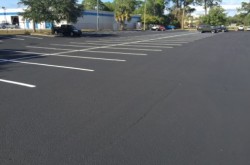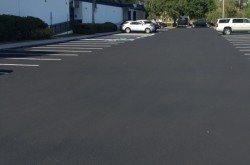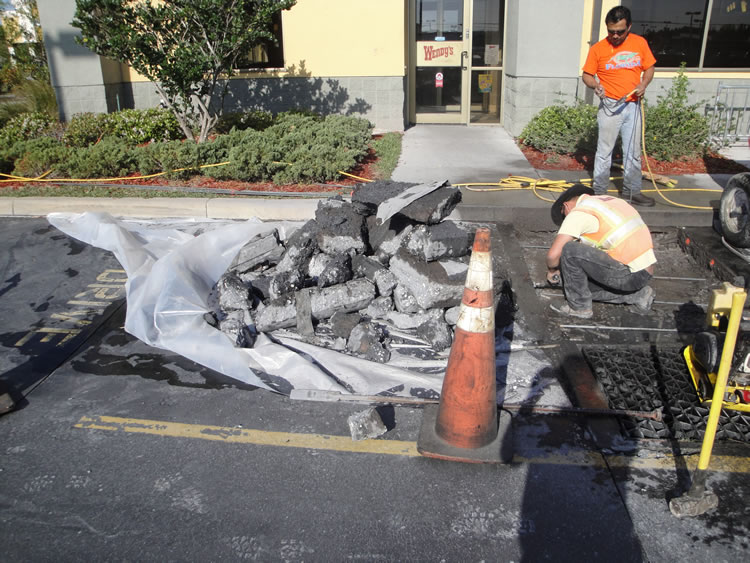Seal Coat and Paving
With the high cost of replacing an existing parking lot, it is important to do the regular preventive maintenance to help preserve your investment. Since your parking lot is the first thing that your customers see when they come to your business, a good impression is essential. Let us help protect your asphalt investment while improving your image. We are fully insured with automotive, general liability and workman’s compensation coverage.
We offer seven day-a-week asphalt repair and sealcoating for your convenience. We can also do your parking lot in sections on different days to minimize disruption of your business. Our sales manager will come out to evaluate your parking lot with you. He can go over any concerns you may have and answer all your questions. If you have a small strip mall where several businesses are located, we can contact the owners for you.
Asphalt

Striping

Sealcoating

What is Sealcoating?
Pavement maintenance contractors are not only the people who understand the importance of an aesthetically pleasing parking lot.
However, it is usually only the contractor who understands that the best way to maintain a parking lot is with a pavement maintenance plan. Pavement maintenance plans can vary in scope, but they never vary in purpose: to increase pavement life.
A pavement maintenance plan usually includes crack filling, pothole repair, and sealcoating, but it also can include sweeping. Sealcoating is one of the most important elements of a pavement maintenance plan because it slows pavement deterioration
A sealcoat consists of either refined coal tar pitch (delivered from coke, a byproduct of the steel production process) or asphalt cement, (a byproduct of the petroleum-refining process) mixed with inert fillers, water, emulsifying agents, or additives. Applied in thin coats, this surface treatment is used to protect off-highway asphalt pavement surfaces such as parking lots, driveways, runways, service stations and heliports.
However, a sealcoat, like all pavement maintenance repairs, is a temporary means of inhibiting pavement deterioration and needs to be applied on a regular basis–about every two or three years.
If applied properly at the right time, sealcoating benefits the pavement in many ways:
- Beautification. Fresh sealcoat brings a dark black color to the pavement, making it look and wear like new. A black parking lot has a clean, rich look that presents a positive image of the company, facility, or residential complex. Striping also enhances the beauty of a newly seal-coated parking lot.
- Slows oxidation and water penetration. Exposure to oxygen hardens asphalt binders and results in a brittle pavement surface that soon cracks. These cracks permit water to penetrate into the subbase, weakening it and reducing pavement strength. This in turn leads to more cracks, which can eventually expand and become potholes. Sealcoats fill surface voids, reducing exposure to oxygen and prolong pavement life.
- Resists gas and oil spills. Gasoline or oil leaking from an engine can soften asphalt. Because coal tars aren’t soluble in gas or oil, coal tar sealers prevent this damage. And manufacturers of asphalt emulsion sealers usually add polymers to increase the resistance to gas or oil. By filling surface voids, sealing reduces the depth to which oil or gas can penetrate.
- Easier to clean and maintain. Sealcoat’s fill surface voids while coating the pavement surface. The resulting smooth and even texture makes surfaces easier to maintain year-round.
- Increased pavement flexibility. A sealcoat keeps a parking lot black. The blacker it is, the more heat it draws from the sun; the more heat it draws, the more pliable it is, the more able it is to withstand traffic volume changes without cracking.
- Protects asphalt from pressure washing. Sealcoat protects asphalt concrete from high-volume water pressure and detergents used in pressure washing dumpster areas and food-processing equipment.
- Cost-effective in the long run. The price of asphalt concrete will always be affected by crude oil prices, which fluctuate when supplies vary. It’s less expensive to sealcoat a parking lot every couple of years using a coal tar or asphalt emulsion than it is to overlay or place a new lot.
Most parking lots require two coats of sealer; home driveways usually receive one coat. Three coats are recommended only for surfaces that experience continuous traffic, such as drive-through lanes at restaurants and banks. Application procedures remain the same. Both types of sealers have a per-gallon coverage rate (when diluted) of about 35-50 square feet, depending on texture of the pavement surface.
- First coat. A contractor uses either a squeegee, brush, spray wand, or distributor truck to place material in continuous parallel strips over the entire pavement surface. To eliminate all ridges and air pockets, a worker then spreads the sealer uniformly across the whole surface, including hard-to-reach areas near parking curbs. Every coat of sealer should be thin (0.1 to 0.15 gallon per square yard) so it dries quickly and evenly. A sealcoat is dry when it is not sticky to the touch (time allowance: about 3 hours).
- Second coat. The surface of the first coat must be clean before a second coat can be applied. Loose dirt can be blown off or swept off; hardened dirt or mud should be scrubbed off with a little water and rotating brush. The second coat should be of the same consistency as the first coat and can be applied in a like manner (some contractors do prefer to squeegee-apply a first coat and spray a second coat). To enhance bonding between both coats, the second should be applied at right angles to the first. After the second coat is applied, the area should be blocked off for at least 24 hours to ensure a thorough curing of both sealcoats
SpecBuilt Seal & Paving uses SealMaster as the primary supplier of seal coat materials.
Contractors, highway/street departments, and property owners have come to rely on SealMaster for quality products and service. SealMaster is driven by a philosophy of total dedication to the pavement maintenance industry.
Quality products, competitive pricing, outstanding service, and a strong commitment to research and development are the reasons why SealMaster continues to be an industry leader. A complete line of pavement maintenance products, sport surfacing materials, and equipment are available for pickup or delivery at SealMaster stores nationwide.
